|
The Influence of the
Grand Tour on
Antique Collecting
by Bob Brooke
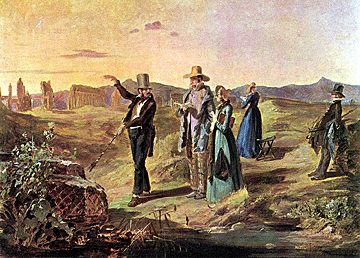 Today’s antique collector most likely doesn’t think
about how the idea of collecting began and the influence the Grand Tour
played in it. But if it weren’t for the Grand Tour, many of the
decorative styles in furniture and accessories—Adams, Sheraton,
Heppelwhite, Chippendale, and Rococo and Renaissance Revival—collected
today would probably not have even been created. Today’s antique collector most likely doesn’t think
about how the idea of collecting began and the influence the Grand Tour
played in it. But if it weren’t for the Grand Tour, many of the
decorative styles in furniture and accessories—Adams, Sheraton,
Heppelwhite, Chippendale, and Rococo and Renaissance Revival—collected
today would probably not have even been created.
The sons of elite English families of the 17th,18th , and early 19th
centuries often spent two to four years traveling around Europe as an
extension of their education to broaden their horizons and learn about
language, architecture, geography, and culture in an experience known as
the Grand Tour. The custom flourished from about 1660 until the creation
of railroad networks in the 1840s. Though primarily associated with the
British nobility, the sons, and later daughters of wealthy landed gentry
also made similar trips. The sons of wealthy American families began
making the journey after the American Revolution.
How It All Began
Richard Lassels, an expatriate Roman Catholic priest, first used the
phrase “Grand Tour” in his 1670 book Voyage to Italy, published
posthumously in Paris in 1670. In its introduction, Lassels listed four
areas in which travel furnished "an accomplished, consummate traveler"
with opportunities to experience first hand the intellectual, the
social, the ethical, and the political life of the Continent.
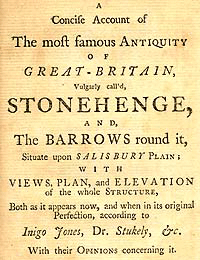 The English gentry of the 17th century believed that what a person knew
came from the physical stimuli to which he or she has been exposed.
Thus, being on-site and seeing famous works of art and history was an
all important part of the Grand Tour. So most Grand Tourists spent the
majority of their time visiting museums and historic sites. The English gentry of the 17th century believed that what a person knew
came from the physical stimuli to which he or she has been exposed.
Thus, being on-site and seeing famous works of art and history was an
all important part of the Grand Tour. So most Grand Tourists spent the
majority of their time visiting museums and historic sites.
Once young men began embarking on these journeys, additional guidebooks
and tour guides began to appear to meet the needs of the 20-something
male and female travelers and their tutors traveling a standard European
itinerary. They carried letters of reference and introduction with them
as they departed from southern England, enabling them to access money
and invitations along the way.
With nearly unlimited funds, aristocratic connections and months or
years to roam, these wealthy young tourists commissioned paintings,
perfected their language skills and mingled with the upper crust of the
Continent.
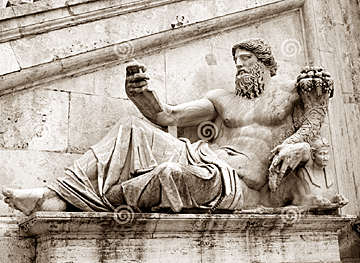 The wealthy believed the primary value of the Grand Tour lay in the
exposure both to classical antiquity and the Renaissance, and to the
aristocratic and fashionably polite society of the European continent.
In addition, it provided the only opportunity to view specific works of
art, and possibly the only chance to hear certain music. A Grand Tour
could last from several months to several years. The youthful Grand
Tourists usually traveled in the company of a Cicerone, a knowledgeable
guide or tutor. The wealthy believed the primary value of the Grand Tour lay in the
exposure both to classical antiquity and the Renaissance, and to the
aristocratic and fashionably polite society of the European continent.
In addition, it provided the only opportunity to view specific works of
art, and possibly the only chance to hear certain music. A Grand Tour
could last from several months to several years. The youthful Grand
Tourists usually traveled in the company of a Cicerone, a knowledgeable
guide or tutor.
However, the Grand Tour was neither a scholar's pilgrimage nor a
religious one. Many Grand Tourists traveled with all the trapping—valets
and coachmen, perhaps a cook, and certainly a scholarly guide.
For gentlemen, some works of art were essential to demonstrate the
breadth and polish they had received from their tour. In Rome, Thomas
Jenkins provided access to private collections of antiquities. Many had
their portraits painted by Pompeo Batoni while posing among Roman
antiquities.
The Acquisition of Souvenirs
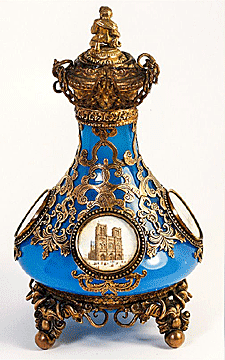 The Grand Tour not only provided a cultural education but allowed those
who could afford it the opportunity to buy things otherwise unavailable
at home, which increased the participant’s prestige and standing. Grand
Tourists would return with crates of art, books, pictures, sculpture,
and items of culture, which would be displayed in libraries, cabinets,
gardens, and drawing rooms, as well as the galleries built purposely for
their display. The Grand Tour became a symbol of wealth and freedom and
fueled the collections that would later become the foundation for
today’s antique market. The Grand Tour not only provided a cultural education but allowed those
who could afford it the opportunity to buy things otherwise unavailable
at home, which increased the participant’s prestige and standing. Grand
Tourists would return with crates of art, books, pictures, sculpture,
and items of culture, which would be displayed in libraries, cabinets,
gardens, and drawing rooms, as well as the galleries built purposely for
their display. The Grand Tour became a symbol of wealth and freedom and
fueled the collections that would later become the foundation for
today’s antique market.
An extensive tour through Italy as far as Naples undertaken by the
“Collector” Earl of Arundel, together with his wife and children between
1613 and 1614 is what established the precedent for collecting while on
the Tour. This is partly because he asked Inigo Jones, not yet
established as an architect but already known as a great traveler, to
act as his Cicerone.
The Grand Tourist was typically a young man with a thorough background
in Greek and Latin literature as well as some leisure time, some means,
and some interest in art. Most Grand Tourists, however, stayed for
briefer periods and set out with less scholarly intentions, accompanied
by a teacher or guardian, and expected to return home with souvenirs of
their travels as well as an understanding of art and architecture formed
by exposure to great masterpieces.
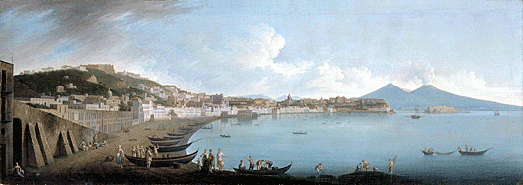
The Itinerary
The Grand Tourists wanted to visit Paris, Rome, and Venice, cities
considered the major centers of culture at the time. Florence and Naples
were also popular destinations. The Grand Tourist would travel from city
to city and usually spend weeks in smaller cities and up to several
months in the three key cities. Paris was definitely the most popular
destination.
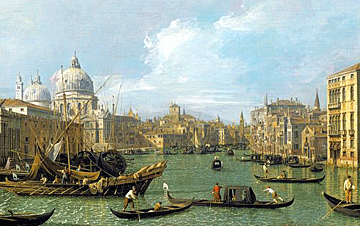 The most common itinerary of the Grand Tour began in Dover, England, and
crossed the English Channel to Ostend, in Belgium, or to Calais or Le
Havre in France. The trip from Dover across the Channel on to Paris
customarily took three days. The crossing of the Channel was not an easy
one as there were risks of seasickness, illness, and even shipwreck. The most common itinerary of the Grand Tour began in Dover, England, and
crossed the English Channel to Ostend, in Belgium, or to Calais or Le
Havre in France. The trip from Dover across the Channel on to Paris
customarily took three days. The crossing of the Channel was not an easy
one as there were risks of seasickness, illness, and even shipwreck.
From Ostend or Calais, the Grand Tourist could hire or purchase a coach,
which he could resell in any city or disassemble and pack to portage
across the Alps. Some chose to make the trip by boat as far as the Alps,
either traveling up the Seine to Paris, or up the Rhine to Basel.
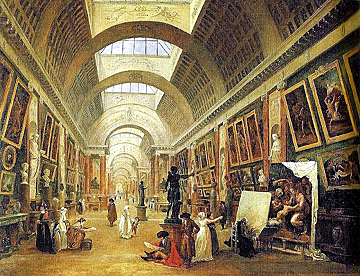 Upon hiring a French-speaking guide—French was the dominant language of
the elite in Europe during the 17th and 18th centuries—the Grand Tourist
and his entourage would travel to Paris. There he might take lessons in
French, dancing, fencing and riding. The appeal of Paris lay in the
sophisticated language and manners of French high society, for French
was the language of diplomats and would prepare the young man for a
leadership position at home, often in government or diplomacy. Upon hiring a French-speaking guide—French was the dominant language of
the elite in Europe during the 17th and 18th centuries—the Grand Tourist
and his entourage would travel to Paris. There he might take lessons in
French, dancing, fencing and riding. The appeal of Paris lay in the
sophisticated language and manners of French high society, for French
was the language of diplomats and would prepare the young man for a
leadership position at home, often in government or diplomacy.
From Paris he would typically go to Geneva, Switzerland. From there, the
Grand Tourist would endure a difficult crossing over the Alps into
northern Italy, which included dismantling his carriage and luggage. If
wealthy enough, he might be carried over the hard terrain by servants.
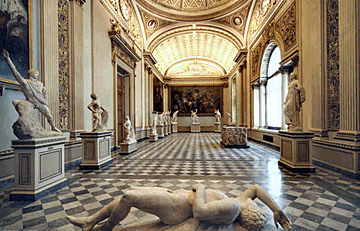 Once in Italy, he would visit Turin, then might spend a few months in
Florence, where there was a large expat English community. The Uffizi
Gallery offered in one place Roman sculptures and Renaissance paintings
and sculptures that would later inspire galleries adorned with
antiquities at home. While in Florence, he might make side trips to
Pisa, Padua, Bologna, and Venice. The British saw Venice as the epitome
of decadent Italian culture, making it a highlight of the Grand Tour. Once in Italy, he would visit Turin, then might spend a few months in
Florence, where there was a large expat English community. The Uffizi
Gallery offered in one place Roman sculptures and Renaissance paintings
and sculptures that would later inspire galleries adorned with
antiquities at home. While in Florence, he might make side trips to
Pisa, Padua, Bologna, and Venice. The British saw Venice as the epitome
of decadent Italian culture, making it a highlight of the Grand Tour.
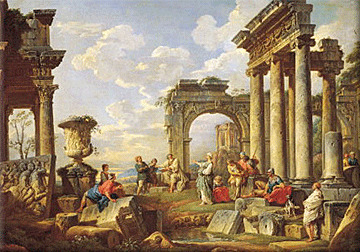 From Venice Grand Tourists traveled to Rome to study the ruins of
ancient Rome, and the masterpieces of painting, sculpture, and
architecture of Rome's Early Christian, Renaissance, and Baroque
periods. Some also visited Naples to study music, and after the mid-18th
century, the archaeological sites of Herculaneum and Pompeii. But Naples
was the usual southern end of the tour. From Venice Grand Tourists traveled to Rome to study the ruins of
ancient Rome, and the masterpieces of painting, sculpture, and
architecture of Rome's Early Christian, Renaissance, and Baroque
periods. Some also visited Naples to study music, and after the mid-18th
century, the archaeological sites of Herculaneum and Pompeii. But Naples
was the usual southern end of the tour.
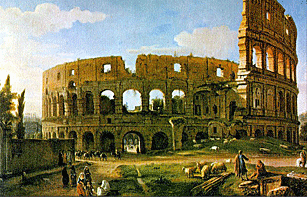 On the return, Grand Tourists traveled north through Italy, traversing
the Alps and heading north through to the German-speaking parts of
Europe. Travelers might stop first in Innsbruck before visiting Vienna,
Dresden, Berlin and Potsdam, with perhaps some study time at the
universities in Munich or Heidelberg. From there they visited Holland
and Flanders, visiting more galleries, before returning across the
Channel to England. On the return, Grand Tourists traveled north through Italy, traversing
the Alps and heading north through to the German-speaking parts of
Europe. Travelers might stop first in Innsbruck before visiting Vienna,
Dresden, Berlin and Potsdam, with perhaps some study time at the
universities in Munich or Heidelberg. From there they visited Holland
and Flanders, visiting more galleries, before returning across the
Channel to England.
Since there were few museums anywhere in Europe before the end of the
18th century, Grand Tourists often saw paintings and sculptures by
gaining admission to private collections, and many were eager to acquire
examples of Greco-Roman and Italian art for their own collections. In
England, where architecture was increasingly seen as an aristocratic
pursuit, noblemen often applied what they learned from the villas of
Palladio in Venice and the evocative ruins of Rome to their own country
houses and gardens, as well as to the furniture and accessories they
contained.
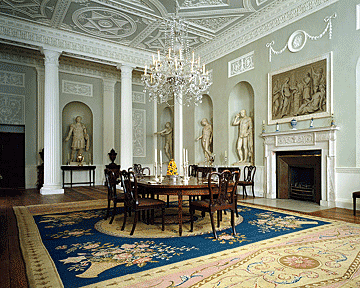 The dining rooms of Robert Adam's interiors, for example, typically
incorporated classical statuary. The second earl of Shelburne was a
particularly voracious collector. He brought back nine lifesized figures
which he set into niches in his dining room at Lansdowne. And when the
second duchess of Portland obtained a Roman cameo glass vase in a
much-publicized sale, Josiah Wedgwood produced jasper ware reproductions
of it. The dining rooms of Robert Adam's interiors, for example, typically
incorporated classical statuary. The second earl of Shelburne was a
particularly voracious collector. He brought back nine lifesized figures
which he set into niches in his dining room at Lansdowne. And when the
second duchess of Portland obtained a Roman cameo glass vase in a
much-publicized sale, Josiah Wedgwood produced jasper ware reproductions
of it.
After the arrival of steam-powered transportation in 1825, the Grand
Tour continued, but with several major differences. It was less
expensive to undertake, safer, easier, and most importantly, open to
anyone. During much of the 19th century, most educated young men of
privilege undertook the Grand Tour. Later, it became fashionable for
young women to do so as well. Who can forget the trip to Italy, with a
spinster aunt as chaperon, Baedecker guide in hand, featured in E. M.
Forster's novel A Room with a View.
<
Back to More Special Features
Next Article > |
